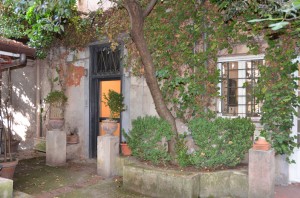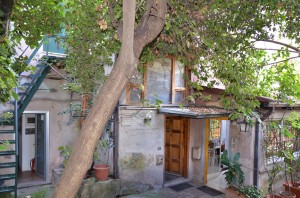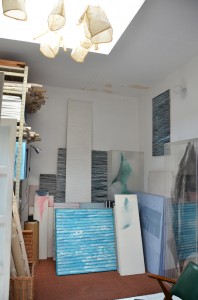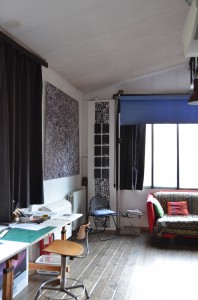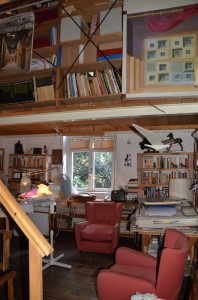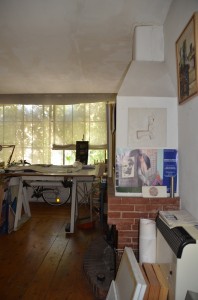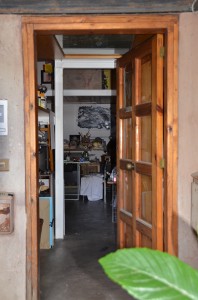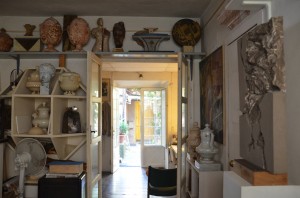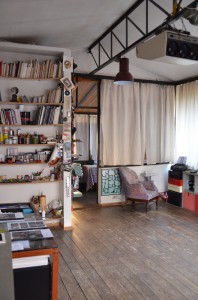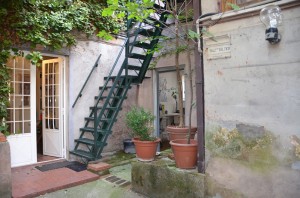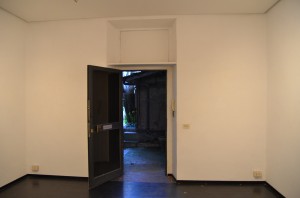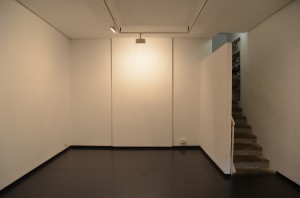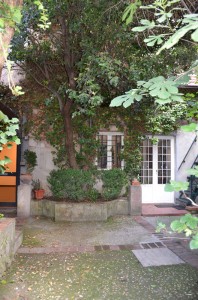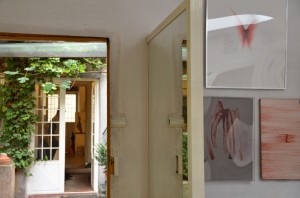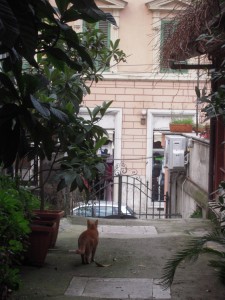la storia dell’Aocf58
Francesco Vaccaro: Vengo a visitarti, casa verissima 2013
Scroll down for English version
L’associazione AOC F58 nasce nel 1984, con sede in via Flaminia 58, Roma.
L’AOC F58 è costituita da un gruppo di artisti e architetti, attualmente sette che, oltre alla normale attività di atelier, autogestiscono uno spazio comune dedicato a mostre, installazioni ed eventi, secondo una tradizione ben consolidata dei luoghi.
Questa attenzione verso l’esterno, che comporta una costante attività di promozione culturale anche fuori dai circuiti tradizionali, inizia nel 1988 e tutt’oggi prosegue come obbiettivo centrale del gruppo, cui si accompagna un’opera di rivisitazione e testimonianza delle molte presenze artistiche, allora solitarie, che si sono qui avvicendate negli anni.
Il suo obiettivo è quello di promuovere e attuare iniziative artistiche, sia nella più generale dimensione di interscambio culturale, sia come espressione della dinamica dei luoghi, di quel quartiere Flaminio che, con bella tradizione, seguita a ospitare artisti delle più svariate tendenze e discipline.
La dimensione artistico-collettiva è un atto fondante dell’AOC F58.
Il perseguimento di questa comune ragione, oltre alla conduzione della galleria d’arte come tale, apre di fatto a contatti e contaminazioni sia nel campo degli operatori, vedi studenti, accademie e istituzioni di settore, sia nel campo della ricerca, vedi musica, letteratura, cinema, fotografia, nella promozione di talenti e nicchie di qualità.
Il numero delle iniziative intraprese dall’associazione è altissimo, con un’eco costante sulla stampa e con una “certificazione di qualità” data dagli annuari editi dall’Assessorato alle Politiche culturali di Roma: “Roma in Mostra”- ’92/’93 ed. Carte Segrete – ’94 ed. Joyce & co. – ’95 ed. Cangemi – ’96/’98 ed. Monsignori.- roma contemporanea 1999/2001 ed. Joyce & co – e in corso di stampa l’ultimo catalogo di Roma contemporanea 2002/2004.
Vi sono stati e vi sono contatti privilegiati, sia con istituzioni pubbliche che con le relative rappresentanze di studenti delle facoltà di architettura di Roma e del sud, dell’Istituto Europeo di Design, degli Istituti d’Arte, dei Licei Artistici, ecc., per una attività di continuo interscambio che possa, in qualunque momento e in tempi brevi, cogliere l’attimo culturalmente significativo di una riflessione collettiva o di un flash isolato nell’ignoto dell’arte.
Nel 2001/2002 collaborazione con AAM/Moschini con mostra in contemporanea per Bruno Lisi.
E’ motivo d’orgoglio, per l’associazione AOC F58, constatare come la sua sede e i suoi studi d’arte siano divenuti “luoghi deputati” dell’interscambio culturale romano, anche nell’aura della vicina piazza del Popolo e per l’essere da sempre,la via Flaminiaproprio fuori porta, meta e luogo di lavoro di artisti e del loro variegato ambiente, tutti magari all’osteria dei pittori.
Negli stessi locali dell’associazione si sono via via avvicendati artisti come Dall’Anese, Modotti, Crocetti, Mannucci, Gentilini, Pettimelli, Ferreri, Shachter, Marchi, Usai, Attardi, Perilli, Avenali, Consorti, Socrate e, attualmente, Forti, Lisi, Nicolosi, Rosato, Sasso.
In tal senso l’Associazione si sta attivando per il recupero e la riproposizione di tale memoria storica, in forma di mostre, pubblicazioni, video, illustrativi e reinterpretativi, sulla scia del bel libro di Ugo Pirro, “Osteria dei pittori”, dedicato alla Trattoria; Menghi, la mitica trattoria “da Menghi”.
Il carattere dell’associazione è aperto e ospitale, ben espresso dalla forma della sua sede, una piazzetta con attorno la galleria e gli atelier degli artisti.
In occasione delle mostre gli studi si aprono, circolare e curiosare è un atto dovuto, laddove il carattere collettivo si sposa con il carattere artigianale del lavoro quotidiano.
L’AOC F58 è precursore degli “Studiaperti & Artisti Associati – Percorsi di arte contemporanea degli studi degli artisti”, manifestazione cui per altro partecipa dal 2000.
L’AOC F58 non ha fini di lucro e promuove iniziative in maniera aperta e gratuita, qualificandosi come un soggetto lontano dalla figura del gallerista tradizionale, nella linea di un’originale forma di autogestione e scambio diretto fra operatori culturali.
La scelta delle mostre personali avviene su un arco di richieste, inoltrate da parte degli artisti, nell’ottica di privilegiare, oltre alla qualità, in sé, delle opere, i materiali inediti, le ricerche più innovative e ogni esperienza che facesse intravedere un positivo ricambio generazionale.
Il programma delle attività previste per ogni anno, ricopre un arco di tempo di nove mesi, senza soluzioni di continuità, a partire da ottobre/novembre a giugno/luglio; l’intero periodo, è suddiviso in spazi di tre settimane circa, già definiti da mostre di artisti singoli, la settimana a disposizione fra una mostra già programmata e l’altra per manifestazioni e performance estemporanee.
Le settimane a disposizione rappresentano con tutta evidenza, come per gli anni precedenti, ma ora in maniera più consapevole e mirata, quella dimensione “sociale” e “promozionale”, che fanno, dell’AOC-F 58. una associazione culturale assolutamente interessata a tutte le esperienze culturali, di Roma o che a Roma possono convergere, nel segno della assenza di fini di lucro e della massima libertà di espressione.
Il rapporto stretto fra preparazione di un programma annuale di materiali relativamente sedimentati e disponibilità al quotidiano svolgersi di esperienze di ricerca, costituisce il segno e il segnale che l’AOC-F58 continua a inviare a tutti gli operatori del settore.
L’AOC è ciò che ha esposto nella sua galleria.
Un’esperienza senza misura di segni, di chiacchere e di volti.
Nulla di più. E anche nulla di meno, però.
Quando gli artisti ospitano altri artisti. Perché li stimano.
Mescolando i critici con gli amici e gli amici con i critici.
Ben oltre la retorica (giusta per altro) degli “studi aperti” e della “libertà d’espressione”.
Il resto, inafferrabile, che si perde nel fluire delle quotidianità ospitali di ogni studio.
Ci sentiamo un piccola istituzione, perché usufruiamo di spazi pubblici. Ci sentiamo una piccola istituzione anche perché la parola “autonomia” ci sembra portare con sé un senso di responsabilità in più verso gli altri (oltre che verso le nostre, per altro non univoche, idee sul fare e parlare d’arte).
Ci piacciono i giovani artisti ma anche i vecchi artisti rimasti “in penombra”, laddove patrimoni di sapere, di fare e di vedere vanno palesemente perduti, laddove il “piccolo” di istituzioni come la nostra può ancora garantire forme di civiltà non attese, non comuni, spesso fortemente identitarie.
Ci predisponiamo ad accogliere, ospitare, mescolare, meticciare chiunque a qualsiasi titolo o ragione giri attorno al mondo dell’arte, intellettuali, artisti o semplici curiosi, nella convinzione che non sia tanto l’”evento” a determinare lo scarto di conoscenza, quanto la rottura delle barriere fra generi, fra ruoli, fra momenti sacri o meno del fare arte.
Per quanto detto, nell’occasione del venticinquesimo anno di attività dell’AOC F58, noi tutti porgiamo a tutti il benvenuto nella galleria, negli studi e nella piazzetta dell’ex fico.
About Aocf58
AOC F58 was founded in 1984 in via Flaminia 58, Roma, Italy.
AOC F58 is a group of artists and architects who, as well as pursuing their own artistic activity, also manage a common space dedicated to exhibitions, installations and events, following a well-established, site-specific tradition.
This attention focused on the work of other artists, which involves a constant activity of cultural promotion even outside the traditional circuits, began in 1988 and is still very much alive today as the main goal of the group. This activity is matched by a work of revisitation and testimony of the many artists who had their studio here in the course of various decades.
AOC’s main objective is to promote and organise artistic events, both in the more general sense of cultural exchange and as a dynamic expression of the place, the area of Flaminio which, thanks to its glorious tradition, continues to be favoured by artists of various inclinations and disciplines.
The artistic-collective dimension is a founding act for AOC F58.
By pursuing this common goal and by directing their art gallery, AOC’s members have the effective possibility to create contacts and contaminations both with those who operate directly in the field of art – that is students, artists, art academies and institutions – and with researchers – in music, literature, cinema, photography – with the aim of promoting and scouting new talents.
The number of events and art shows organised by AOC F58 is very high. They are constantly recorded in the press and ‘certified’ for their quality by the yearbooks published by Assessorato alle Politiche culturali di Roma (Department for Cultural Affairs of Rome): “Roma in Mostra”, 1992/1993, published by Carte Segrete; 1994, published by Joyce & co.; 1995, published by Cangemi; 1996/1998, published by Monsignori; Roma contemporanea, 1999/2001, published by Joyce & co.; up to the last catalogue of contemporary art in Rome, 2002/2004.
There have been privileged contacts with public institutions and with representatives from the faculties of architecture of Rome and of the South of Italy, with the Istituto Europeo di Design, with art institutes, art schools, etc., to develop an activity of constant exchange which may be able, at any time and quite rapidly, to seize the culturally significant moment of a collective reflection or of an isolated flash in the unfathomable realm of art.
In 2001/2002 we remember the collaboration with AAM/Moschini: an exhibition of Bruno Lisi taking place in both galleries.
It is a point of pride, for the association AOC F58, to see how its gallery and its art studios have been recognised as some of the favourite places dedicated to the Roman cultural exchanges, also thanks to the aura bestowed by piazza del Popolo, just nearby, and to the fact that via Flaminia, immediately outside the centre of Rome, has always been the place chosen by artists and by their varied milieu, all of them probably gathering at the osteria dei pittori (painters’ tavern) in via Flaminia.
In the same studios of the association the following artists worked: Dall’Anese, Modotti, Crocetti, Mannucci, Gentilini, Pettimelli, Ferreri, Shachter, Marchi, Usai, Attardi, Perilli, Avenali, Consorti, Socrate, Lisi and, today, Forti, Nicolosi, Rosato, Sasso are still pursuing an intense activity.
In that sense, the Associazione is active in restoring and reproposing such historical memory, through art shows, publications, illustrative and interpretational videos, in the wake of the beautiful book by Ugo Pirro, Osteria dei pittori, dedicated to the Trattoria Menghi, the mytical “da Menghi” tavern turned in recent times, unfortunately, into a Chinese restaurant first and a café later.
The character of the association is open and friendly, well expressed by the shape of its headquarters, a small square sorrounded by the gallery and the artists’ studios.
When exhibitions and events take place, studios open their doors and wandering about the place and finding out about its life is the thing to do, in a place where the collective character is matched by the craftmanship of daily work.
AOC F58 is the precursor of “Studiaperti & Artisti Associati – Percorsi di arte contemporanea degli studi degli artisti” (Open Studios & Associated Artists), an event it has committed to since 2000.
AOC F58 is a nonprofit association and promotes events in an open and gratuitous form, qualifying itself as an entity which is distant from that of the traditional gallerist or art dealer, characterised as it is by a form of original self-management and direct contact between cultural operators.
The selection of solo exhibitions is carried out through a process of evaluation of various applications, forwarded by artists, critics and curators, in order to privilege, as well as the quality of the works, the unseen before material, the most innovative researches and every experience which may foreseeably lead to a positive generational turnover.
The programme of the activities scheduled each year covers a period of nine months, starting in October/November until June/July; the entire time is divided in periods of about three weeks for solo or collective exhibitions, while the week in between one show and the next can be used for single events or performances.
The weeks dedicated to the exhibitions show with clear evidence – and have also shown in the past, but today in a more aware and focused way – that ‘social’ and ‘promotional’ dimension which renders AOC F58 an association absolutely interested in all cultural experiences, in Rome or which may converge to Rome, in the absence of any profit-making goal and under the sign of the maximum freedom of expression.
AOC is what it has exhibited in its gallery.
An experience without measure of signs, chit chat and faces.
Nothing more. And nothing less, though.
When artists welcome other artists. Because they like them.
Mixing critics with friends and friends with critics.
Well beyond the rhetoric (quite a right one, for that matter) of ‘open studios’ and ‘freedom of expression’.
The rest, unfathomable, is lost in the flow of the friendly daily life of every studio.
We feel we are a small institution, because our headquarters are in public spaces. We feel we are a small institution even if the word “autonomy” seems to carry a sense of responsibility towards other artists (as well as towards our own, albeit not univocal, ideas on making art and talking about it).
We like young artists but also old artists who are not in the limelight, where treasures of knowledge, creation and visuality are clearly lost, where the ‘smallness’ of an institution like ours can still guarantee forms of unexpected, uncommon, often highly identity-making forms of civilization.
We prepare ourselves to welcome, host, mix, crossbreed anyone who for any reason is active in the world of art – intellectuals, artists or simple enthusiasts – in the conviction that it is not so much the event to spur the acquisition of knowledge, as the breaking of barriers between genres, between roles, between more or less sacred moments of making art.
Having said that, in the occasion of the twentyfifth anniversary from AOC F58’s start of activity, we welcome you all to the gallery, to the studios and to the little square where the giant fig tree used to stand.
